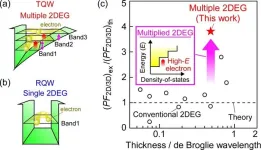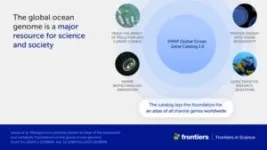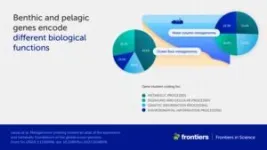(Press-News.org) Osaka, Japan – Imagine stoplights and cars communicating with each other to optimize the flow of traffic. This isn’t science fiction – it’s the Internet of Things (IoT), i.e., objects that sense their surroundings and respond via the internet. As the global population rises and such technologies continue to develop, you might wonder – what will power this digital world of tomorrow?
Wind, solar, yes. Something all around us might not immediately come to mind though – heat. Now, in a study recently published in Nature Communications, a multi-institutional research team including Osaka University has unveiled a breakthrough in clean energy: greatly improved thermoelectric conversion. One of its many potential applications? That’s right, the IoT.
Large-scale, global integration of the IoT is limited by the lack of a suitable energy supply. Realistically, an energy supply for the IoT must be local and small scale. Miniaturization of thermoelectric conversion can help solve this energy-supply problem by applying the otherwise wasted heat from microelectronics as a source of electricity. However, for practical applications, the efficiency of current thermoelectric-energy conversion is insufficient. Improving this efficiency was the goal of the research team’s study.
"In our work, we demonstrate a two-dimensional electron gas (2DEG) system with multiple subbands that uses gallium arsenide. The system is different from conventional methods of thermoelectric conversion," explain Yuto Uematsu and Yoshiaki Nakamura, lead and senior authors of the study. "Our system facilitates better conversion from temperature (heat) to electricity, and improves the mobility of electrons in their 2D sheet. This readily benefits everyday devices like semiconductors."
Incredibly, the researchers were able to improve the power factor of thermoelectric conversion by a factor of 4 compared with conventional 2DEG systems. Other technologies like resonant scattering have not been as efficient for thermoelectric conversion.
The team’s findings could open the way to a sustainable power source for the IoT. Thin thermoelectric films on substrates made of gallium arsenide would be suitable for IoT application. For example, these could power environmental monitoring systems in remote locations or wearable devices for medical monitoring.
"We're excited because we have expanded upon the principles of a process that is crucial to clean energy and the development of a sustainable IoT," says Yoshiaki Nakamura, senior author. "What’s more, our methodology can be applied to any element-based material; the practical applications are far reaching.”
This work is an important step forward in maximizing the utility of thermoelectric power generation in modern microelectronics and is especially suitable for the IoT. As the results are not limited to gallium arsenide, further advancements to the system are possible, with sustainability and the IoT potentially benefitting greatly.
###
The article, "Anomalous enhancement of thermoelectric power factor in multiple two-dimensional electron gas system," was published in Nature Communications at DOI: https://doi.org/10.1038/s41467-023-44165-3
About Osaka University
Osaka University was founded in 1931 as one of the seven imperial universities of Japan and is now one of Japan's leading comprehensive universities with a broad disciplinary spectrum. This strength is coupled with a singular drive for innovation that extends throughout the scientific process, from fundamental research to the creation of applied technology with positive economic impacts. Its commitment to innovation has been recognized in Japan and around the world, being named Japan's most innovative university in 2015 (Reuters 2015 Top 100) and one of the most innovative institutions in the world in 2017 (Innovative Universities and the Nature Index Innovation 2017). Now, Osaka University is leveraging its role as a Designated National University Corporation selected by the Ministry of Education, Culture, Sports, Science and Technology to contribute to innovation for human welfare, sustainable development of society, and social transformation.
Website: https://resou.osaka-u.ac.jp/en
END
Advancement in thermoelectricity could light up the Internet of Things
Researchers from Osaka University and their collaborating partners improve the efficiency of thermoelectric conversion from a semiconductor, which could help optimize the efficiency and sustainability of the global digital transformation
2024-01-16
ELSE PRESS RELEASES FROM THIS DATE:
Largest-ever study of ocean DNA has created essential catalog of marine life
2024-01-16
The ocean is the world’s largest habitat, yet much of its biodiversity is still unknown. A study published in Frontiers in Science marks a significant breakthrough, reporting the largest and most comprehensive database of marine microbes to date – matched with biological function, location, and habitat type.
“The KMAP Global Ocean Gene Catalog 1.0 is a leap toward understanding the ocean’s full diversity, containing more than 317 million gene groups from marine organisms around ...
Research aims to harness technology for improved heart and brain health
2024-01-16
Highlights:
Research teams share findings and progress on projects aimed at harnessing digital solutions — including text messaging, smartphone apps, wearable devices and artificial intelligence — to improve health, reduce health care disparities, empower people to better manage their health and wellness and enhance patient/clinician connectivity in a special issue of the Journal of the American Heart Association.
Topics in this issue include:
the effectiveness of an “EyePhone” smartphone application to diagnose ...
Living in poverty with chronic inflammation significantly increases heart disease and cancer mortality risk, study finds
2024-01-16
In the US, approximately 37.9 million people, or 11.4% of the population, lived below the poverty line in 2022. It has been well demonstrated that poverty negatively affects physical and mental health. For example, people living in poverty run a greater risk of mental illness, heart disease, hypertension, and stroke, and have a higher mortality and lower life expectancy. The mechanisms by which poverty impacts on health outcomes are manifold: for example, people experiencing poverty have reduced access to healthy food, clean water, safe housing, education, and healthcare.
Now, researchers have shown for the first time that the effects of poverty may combine in ...
Chronic inflammation and poverty are a ‘double whammy’ for mortality risk
2024-01-16
A new study led by a University of Florida College of Public Health and Health Professions researcher finds that people with chronic inflammation living in poverty have more than double the risk of dying from heart disease and nearly triple the risk of dying from cancer within the next 15 years. The findings are based on data representing 95 million Americans ages 40 and over.
While chronic inflammation and poverty are each known to increase mortality risk, when combined, the two factors appear ...
No increase in preventable illnesses, deaths in kids during pandemic, but delays in some diagnoses
2024-01-16
Despite major disruptions to health care systems during the COVID-19 pandemic, there was no significant increase in preventable conditions or deaths in children according to a large study published in CMAJ (Canadian Medical Association Journal) https://www.cmaj.ca/lookup/doi/10.1503/cmaj.221726.
To understand the effect of the pandemic on pediatric health care use and children's health, researchers looked at data on emergency visits, hospital admissions and deaths for children aged 0–17 years ...
Cannabis has no clear effect on treatment of opioid addiction, US study finds
2024-01-16
Cannabis is not an effective treatment for opioid addiction, a new peer-reviewed study of thousands of people being treated for opioid use disorder suggests.
Experts, publishing their results today in The American Journal of Drug and Alcohol Abuse, have found that cannabis is having no significant effect on peoples’ use of opioids, taken outside of medical guidance.
The findings have substantial implications for U.S treatment programmes, some of which still require patients to abstain from cannabis before they qualify for potentially life-saving treatment. This is based on ...
COVID-19 vaccine reduces long COVID in children
2024-01-16
Philadelphia, January 16, 2024 – Vaccination against SARS-CoV-2, the virus that causes COVID-19, reduces the risk of serious acute illness in children and adolescents. However, its role in protecting against persistent health problems in the months after COVID-19, or “long COVID,” was less clear. Now, researchers from 17 health systems in the U.S., in work led by investigators at the Children’s Hospital of Philadelphia (CHOP), have found that vaccination provides moderate protection against ...
First all-UK study of 67 million people reveals consequences of missed COVID-19 vaccines
2024-01-16
The first research study of the entire UK population highlights gaps in COVID-19 vaccine coverage. Between a third and a half of the populations of the four UK nations had not had the recommended number of COVID vaccinations and boosters by summer 2022.
Findings suggest that more than 7,000 hospitalisations and deaths might have been averted in summer 2022 if the UK had had better vaccine coverage, according to the paper, published today in The Lancet.
With COVID-19 cases on the rise and a new variant strain recently identified, this research provides a timely insight into vaccine ...
Trazadone and CBT no more effective than placebo for improving insomnia among long-term dialysis patients
2024-01-15
Below please find summaries of new articles that will be published in the next issue of Annals of Internal Medicine. The summaries are not intended to substitute for the full articles as a source of information. This information is under strict embargo and by taking it into possession, media representatives are committing to the terms of the embargo not only on their own behalf, but also on behalf of the organization they represent.
----------------------------
1. Trazadone and CBT ...
Climate change threatens global forest carbon sequestration, study finds
2024-01-15
Climate change is reshaping forests differently across the United States, according to a new analysis of U.S. Forest Service data. With rising temperatures, escalating droughts, wildfires, and disease outbreaks taking a toll on trees, researchers warn that forests across the American West are bearing the brunt of the consequences.
The study, led by UF Biology researchers J. Aaron Hogan and Jeremy W. Lichstein was published in the Proceedings of the National Academy of Sciences. The study reveals a pronounced regional imbalance in forest productivity, a key barometer of ...
LAST 30 PRESS RELEASES:
Numbers in our sights affect how we perceive space
SIMJ announces global collaborative book project in commemoration of its 75th anniversary
Air pollution exposure and birth weight
Obstructive sleep apnea risk and mental health conditions among older adults
How talking slows eye movements behind the wheel
The Ceramic Society of Japan’s Oxoate Ceramics Research Association launches new international book project
Heart-brain connection: international study reveals the role of the vagus nerve in keeping the heart young
Researchers identify Rb1 as a predictive biomarker for a new therapeutic strategy in some breast cancers
Survey reveals ethical gaps slowing AI adoption in pediatric surgery
Stimulant ADHD medications work differently than thought
AI overestimates how smart people are, according to HSE economists
HSE researchers create genome-wide map of quadruplexes
Scientists boost cell "powerhouses" to burn more calories
Automatic label checking: The missing step in making reliable medical AI
Low daily alcohol intake linked to 50% heightened mouth cancer risk in India
American Meteorological Society announces Rick Spinrad as 2026 President-Elect
Biomass-based carbon capture spotlighted in newly released global climate webinar recording
Illuminating invisible nano pollutants: advanced bioimaging tracks the full journey of emerging nanoscale contaminants in living systems
How does age affect recovery from spinal cord injury?
Novel AI tool offers prognosis for patients with head and neck cancer
Fathers’ microplastic exposure tied to their children’s metabolic problems
Research validates laboratory model for studying high-grade serous ovarian cancer
SIR 2026 delivers transformative breakthroughs in minimally invasive medicine to improve patient care
Stem Cell Reports most downloaded papers of 2025 highlight the breadth and impact of stem cell research
Oxford-led study estimates NHS spends around 3% of its primary and secondary care budget on the health impacts of heat and cold in England
A researcher’s long quest leads to a smart composite breakthrough
Urban wild bees act as “microbial sensors” of city health.
New study finds where you live affects recovery after a hip fracture
Forecasting the impact of fully automated vehicle adoption on US road traffic injuries
Alcohol-related hospitalizations from 2016 to 2022
[Press-News.org] Advancement in thermoelectricity could light up the Internet of ThingsResearchers from Osaka University and their collaborating partners improve the efficiency of thermoelectric conversion from a semiconductor, which could help optimize the efficiency and sustainability of the global digital transformation



